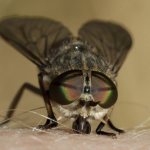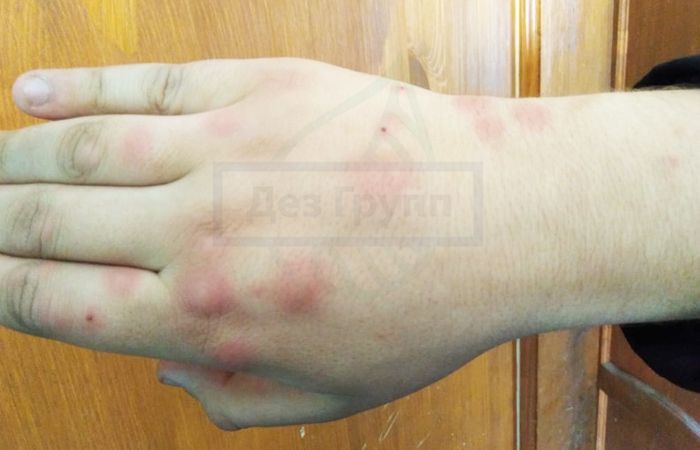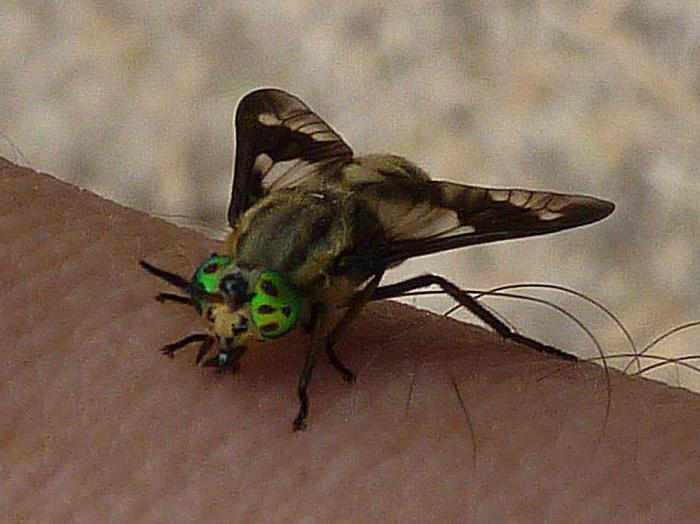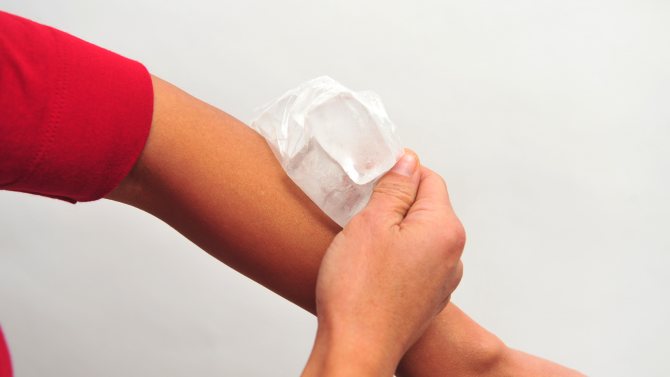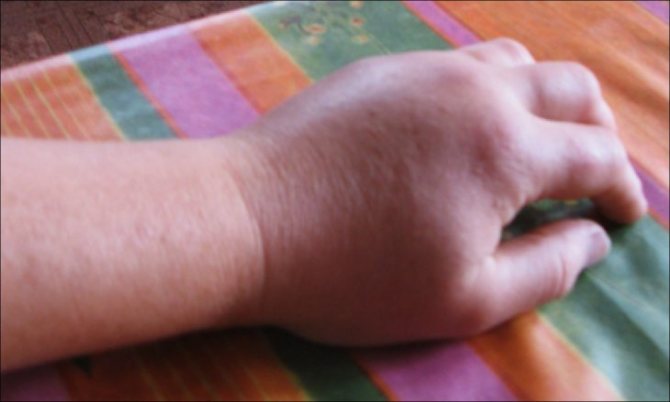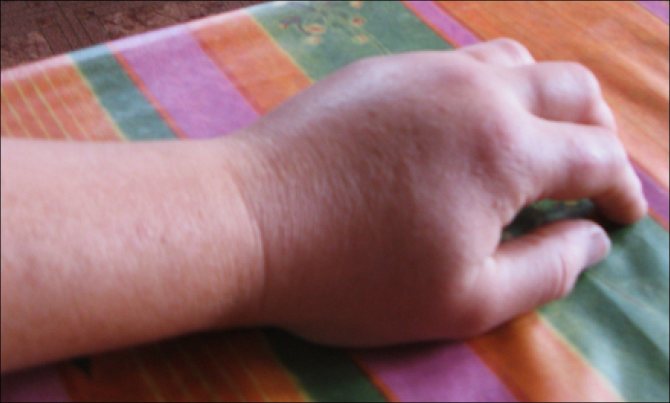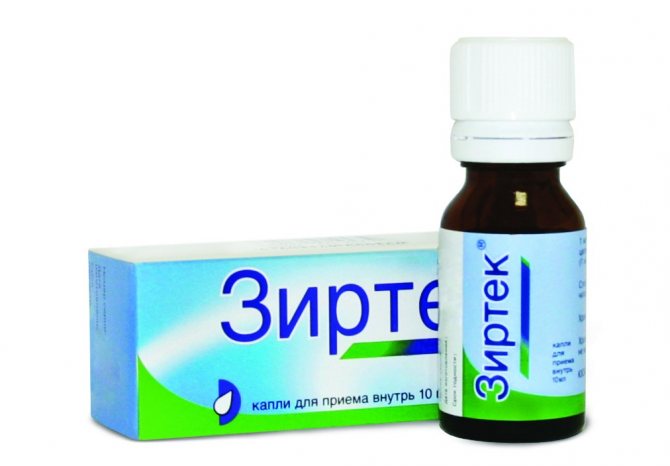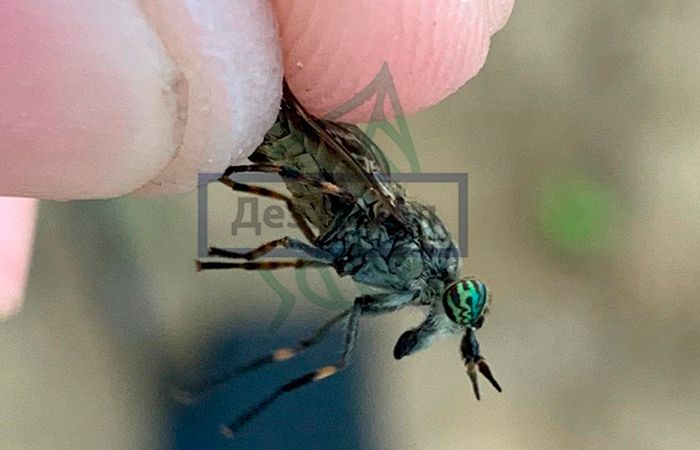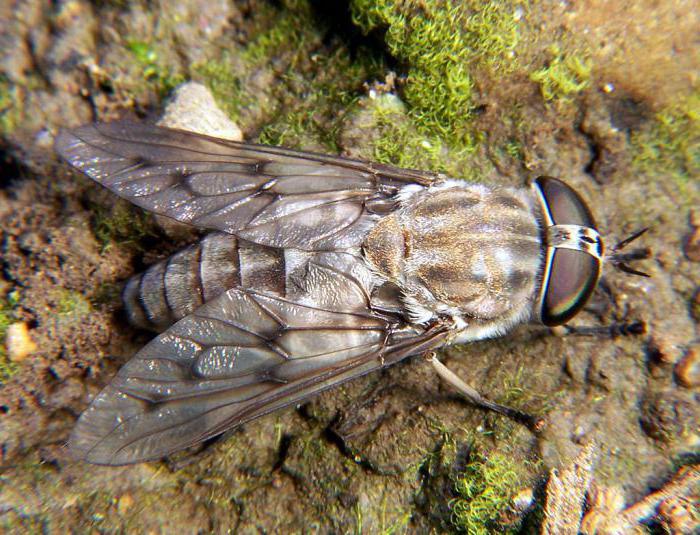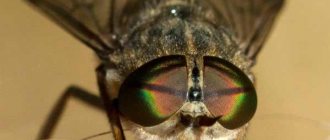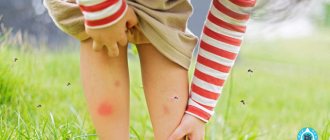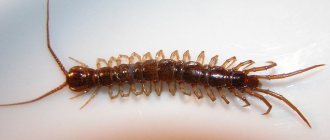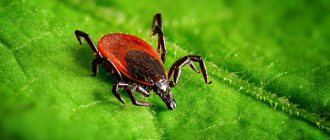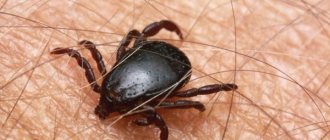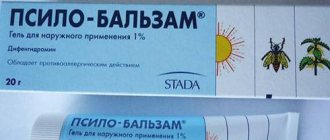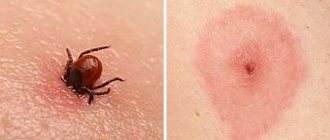Probably, each of us has been bitten by a gadfly or horsefly at least once in our life. Therefore, we all know firsthand how painful and unpleasant it is. At the same time, the bite manifests itself in different ways in all people. Some people experience swelling and itching in just a couple of minutes, while others, on the contrary, experience unpleasant symptoms for several days. What does it depend on? What are the possible consequences of contact with these large flies? What should be done if you are bitten by a horsefly or a gadfly? We will try to answer each of the listed questions in as much detail as possible, as well as share other useful information.
general characteristics
People often call all large gray flies that attack a person, painfully biting through the skin and sucking blood as gadflies. In fact, horseflies do it. The gadfly is not a bloodsucker. This insect lives off the nutrients that it has accumulated in the larval phase. Their oral apparatus is not developed, they do not feed during their life. They look more like bumblebees.
But then why gadflies bite people is a question that not everyone can find an answer to. Males consume only the nectar of flowers, while a fertilized female is looking for a warm-blooded incubator. Therefore, a gadfly bite has a different purpose: to lay eggs under the victim's skin. Usually, the main hosts for the offspring of these insects are cattle, horses, camels, and deer. The larvae live and develop in the body of their host until they turn into adults. And the life cycle repeats again. Parasitism in the human body is very rare.
Interesting!
There are about 150 species of these insects in the world, but only one person attacks - the human skin gadfly. Fortunately, it is only found in Central America.
General information about horseflies
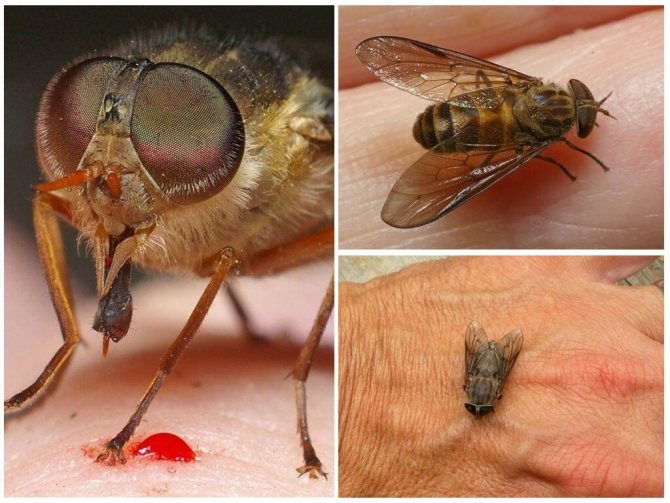
Horsefly
An ordinary person, who does not have serious knowledge of biology, cannot distinguish a gadfly from a gadfly, which belongs to the order of Diptera, but he knows that the bite of a gadfly fly can be painful, therefore he is afraid of such an insect. Horsefly is a blood-sucking parasite. He lives in forest, taiga, forest-steppe zones. In arid areas, the insect can be found mainly near rivers and lakes, in the mountains it settles to the borders with eternal snow.
The people call horseflies gadflies. Only fertilized females, which need blood for the development of eggs, bite humans and animals. Males are smaller and feed on plant nectar. Females have a proboscis in their mouths, with which they cut the victim's skin and inject substances that prevent blood clotting into the wound.
The length of the insect ranges from 6 to 30 mm. The color of the wings is gray, marble, or it can be variegated. Bloodsuckers fly in good weather without rain and wind. The air temperature should be at least +15, but not higher than +32 degrees. Outside these temperature limits, bloodsuckers are inactive.
On a note!
The most common representatives on the territory of our country are raincoats, lacewings and horseflies. They show noticeable activity before rain, but you will not see them in wet weather. Only raincoats can attack a person even during light rainfall.
Features of appearance
In nature, there are about 1600 species of horseflies.All of them are large in size - about 2 cm. The female can be easily distinguished by her large build, large iridescent eyes and a bridge between them.
The insect has an extremely complex oral apparatus. Powerful jaws, piercing, cutting, sucking component. Pierces skin thanks to its fleshy, long proboscis.
The abdomen of the male is pointed, that of the female is rounded. Coloring in gray, brown dull tones. Large eyes are pronounced, which shimmer in the sun with all the colors of the rainbow.
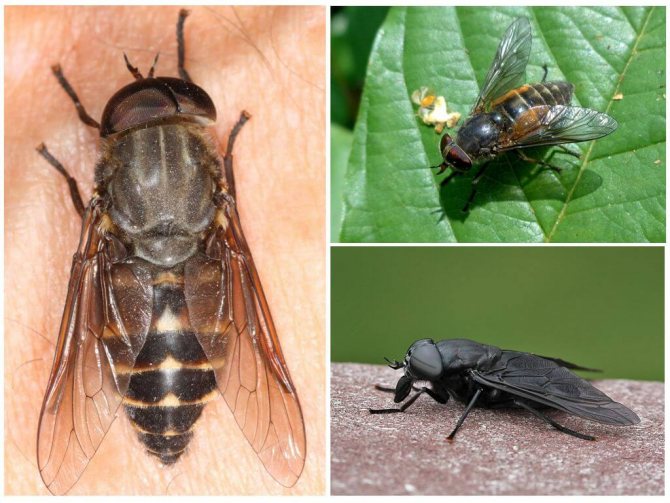

Horsefly
What happens if a gadfly bites
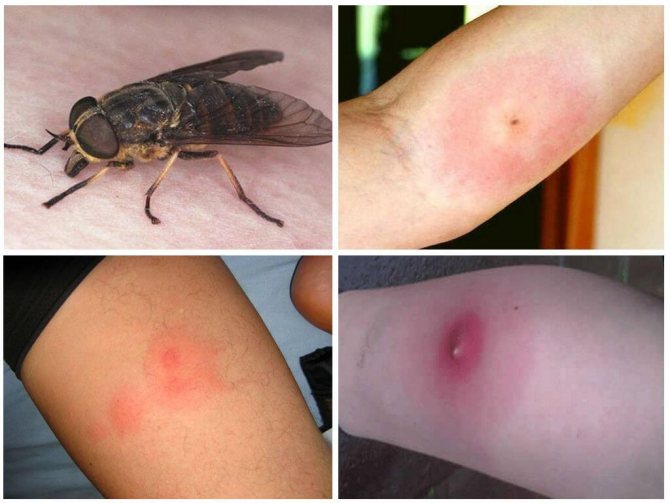

Gadfly bite
If a gadfly has bitten a person, then it is impossible not to notice, since a strong burning sensation and pain is immediately felt, redness appears on the skin, and allergic reactions may occur. A photo of a gadfly bite clearly demonstrates the consequences of an insect attack. The blood in the wound does not coagulate for a long time, so you need to try to get rid of all the insects so as not to be attacked again. Gadflies find the victim with their eyes, which means that you can run away from the bloodsucker.
Immediately there is induration, swelling and redness after a gadfly bite. The skin begins to itch and itch. An allergic person may feel dizziness, fever, swollen lymph nodes, swelling and severe redness in the area of the bite. If there are no complications in the form of allergic reactions (insect saliva is an allergen), then all these unpleasant phenomena disappear in a few days.
The gadfly bite itches strongly. A person, scratching the skin around the wound, can introduce additional infection that will require further treatment. But an allergy to a gadfly bite is quite rare. Cases of poisoning of the human body due to a gadfly bite A photo of a gadfly bite or strong allergic reactions in real life is practically not observed. But sometimes Quincke's edema can even occur.
A dangerous gadfly can be the fact that it is a carrier of diseases such as:
- tularemia;
- anthrax;
- filariasis.
These diseases are transmitted with blood, which the insect can receive from sick people or animals.
Important!
It is difficult to treat such diseases, therefore, when going into nature, you should think in advance about protective equipment. If possible, it is advisable to take the insect to the laboratory, where it will be determined whether it is the causative agent of the infection.
The bite can cause serious illness, so do not delay your visit to the doctor.
Varieties of insects
Frequently encountered species of the described insect include:
- Bovine horsefly - considered to be the largest species of the described family, reaching a length of about 20 mm. Horsefly bovine dipteran insect belonging to the horsefly family. This horsefly species lives in Europe, painted brown, with dark stripes and yellowish hairs located on the body.
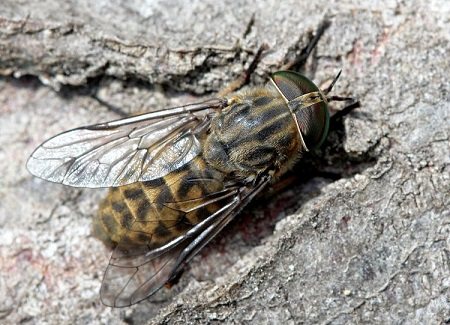

Bull horsefly photo - Gold-eyed or variegated - about 250 species of horseflies are equated to the described genus. The most common horsefly is the common lacewing, reaching a length of 14 mm and having a rather bright color of its body. The chest of this insect casts a blackish color, while the abdomen is complemented by original yellow spots. The wings of the lacewing are mosaic in color, the apex of which is completed by brown spots located on them. Huge faceted eyes cast an emerald-golden color;
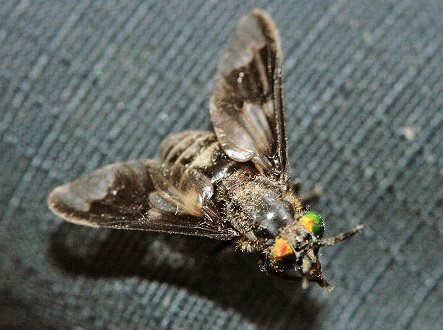

Photo - An ordinary raincoat - which has a modest color and wings with a complex smoky pattern. The described type of insects can produce, so to speak, a real horsefly bite, even in gloomy and cloudy weather.
Manifestation of a parasite bite
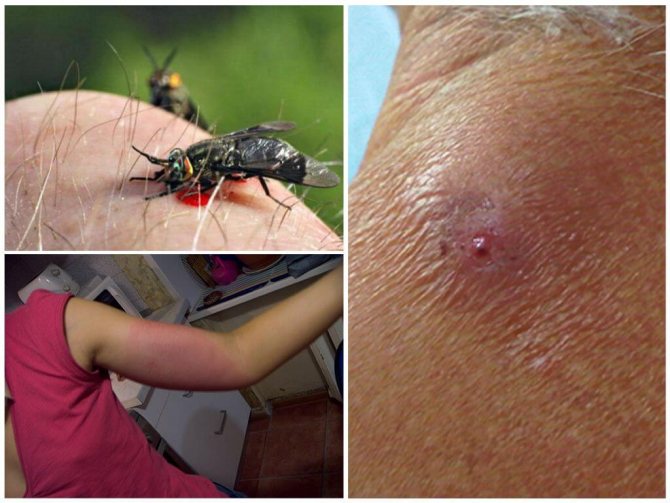

The consequences of a gadfly bite
If you look at the photo of the symptoms of a gadfly bite in a person, then it can be noted that they are very similar to a wasp bite, namely:
- pain;
- burning;
- edema;
- redness of the skin;
- itching;
- poor blood clotting;
- the place of the bite on the skin acquires a certain character, a tumor appears, similar to a neoplasm.
On a note!
The consequences of a gadfly bite, including an allergic reaction, can go away in a couple of days, if no infection gets into the wound and purulent inflammation does not develop as a result.
Treatment of complications
What complications does a gadfly bite carry for the body? Treatment for complex cases is complex. Signs are varied - tachycardia, anxiety, nervousness, difficulty breathing, impaired concentration, and a rash all over the body. First of all, this is the introduction of antitoxic drugs containing immune sera. The secondary stage is the use of diuretic drugs. Therapy with crystalloid solutions and glucocorticoid hormones. And also, if necessary, you need to enter anti-shock drugs. The person is under the supervision of doctors for more than a week. A therapeutic diet is prescribed to normalize the intestines and the intake of vitamin complexes. All treatment is aimed at removing toxins, removing puffiness of organs and generally increasing immunity.
What to do with a gadfly bite
Not all people have come across these insects, so they have no idea how to treat a tumor from a gadfly bite. If a person was bitten by gadflies on vacation, then you need to immediately take appropriate measures. Delay can lead to unpleasant consequences. Always on hand should be the necessary drugs that could be used as first aid for a gadfly bite.
Not many people know what to do when the hand is swollen, the temperature rises or nausea opens. There is no basic knowledge about how to relieve itching from an insect bite. Many mothers do not know which remedy for horsefly and gadfly bites is designed to protect babies. Children's skin is very delicate, which is why it is so attractive to all bloodsucking.
If it happens that the gadfly has bitten the child, regardless of whether the leg or arm is swollen, you should immediately do the following:
- press down firmly on the bite site to prevent the spread of harmful substances from the parasite's saliva;
- relieve itching by cooling the swelling with ice or any cold object;
- wash the wound with cool soapy water;
- treat the bite with any antiseptic: iodine, hydrogen peroxide, brilliant green, alcohol.
It is worth contacting a doctor for help if a large number of insects have bitten a person, or he has a severe allergy in response to a toxin that has entered the bloodstream along with the saliva of a bloodsucker. If no complications are observed, then an insect bite can be treated at home.
How to treat a larval infestation?
The gadfly larva under human skin can most often be found in residents and guests of tropical countries. Many people today visit America, Mexico, Argentina, in the Russian regions there is also a gadfly capable of laying eggs on the skin of animals and humans. You should be aware of this and prepare in advance. It is recommended to adhere to these rules:
- do not appear in places where gadflies live in large numbers;
- wear clothing that protects against bites;
- use repellents that are sold in stores in stock.
Observing such simple rules, gadfly larvae will not appear in the human body. But if this happened, the wound should be treated with the help of special means. If something starts to bother you, you should immediately consult a doctor.
The emergence of any foreign objects inside the body needs immediate removal, in particular when it comes to parasitic creatures. In addition to the fact that the larvae move freely through the body, damaging the tissues, they feed thanks to the host.
In many cases, disinfectants and anti-inflammatory ointments should be used. Only such measures will make it possible to exclude the harmful effects of parasites that inhabit the body.
Diagnostics
For diagnostic purposes of the disease, a blood test is performed, the number of antibodies is determined. The patient will be asked if he was at the site of the spread of the disease. In addition, an external examination is carried out, in which a purulent abscess with a hole is found on the skin. The specialist examines the inflamed lesion using a magnifying glass.
Before removing the larva from under the skin, you need to drink Ivermectin. It is considered to be antiparasitic. Only after this is it possible to start extracting.
Extracting the larva
Before removing the parasite, the site of the abscess must be disinfected. This is done mainly with the help of furacilin. To prevent the insect from breathing, a little oil must be dripped into the hole from where the air penetrated. The larva should then emerge as oxygen deficiency begins. When the gadfly appears from the hole, which is under the skin, it is pulled out with the help of a special device.
When the operation is completed, an antiseptic dressing is applied to the abscess site.
In order to avoid infection by larvae, you need to be careful when traveling, in particular, to tropical countries. It is recommended to adhere to the following rules:
- wear clothes that cover the body as much as possible;
- use repellents;
- when the bite has already taken place, it needs to be treated with an antiseptic;
- if you feel worse, you need to consult a doctor.
Numerous larvae can provoke a variety of consequences, for example:
- allergies;
- purulent infection;
- meningitis, pneumocephalus, ulcer;
- erosion of the nose or eyes.
Lay eggs on a host or use an intermediate. For example, common fly, mosquitoes, in the case of D. hominis, a species of tick.
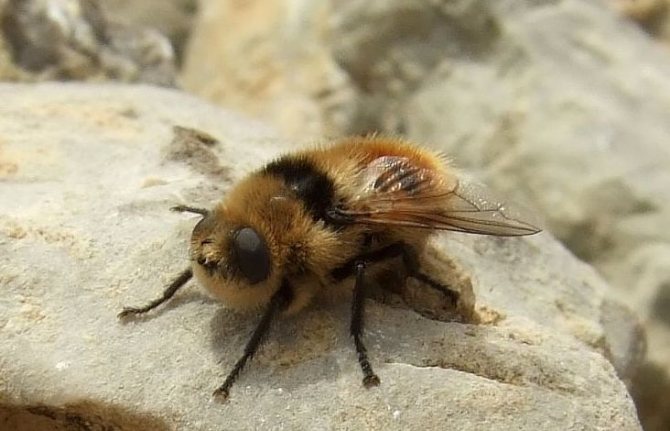

The larvae from the eggs, stimulated by the warmth and proximity of a large mammalian host, fall on its skin and hide under it. Intermediate hosts are often used, as many animals recognize the approach of a gadfly and run away.
Some gadfly larvae parasitize in the digestive tract after being swallowed by licking.
Myiasis is caused by the penetration of larvae under the skin (or mucous membrane) of an animal. The mature larvae fall off the host and complete the pupal stage in the soil. They do not kill the animal, so they are real parasites.
The most common hosts for the human gadfly are:
- cattle;
- dogs.
However, they are found in many warm-blooded animals, including buffalo, cats, dogs, humans, monkeys, pigs, rabbits, and sheep.
Prevention of infection is common sense. Travelers to Central and South America must take preventive measures, use insect repellents, and wear protective clothing. Clothing should cover most, if not all, of the skin.
Any uncovered area should be treated with insect repellents. Where there are many bloodsucking, sleep with a net to keep them out.
Sources of
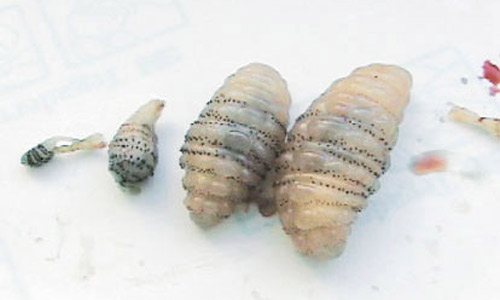

Use of pharmaceutical preparations
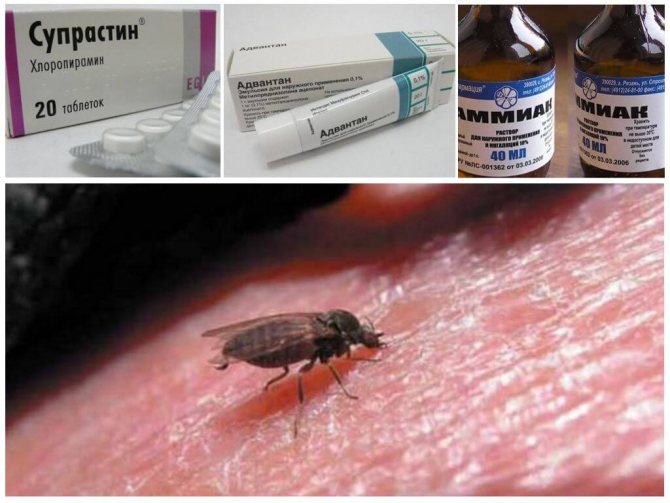

Medicines to relieve swelling from a bite
It happens that there is an inadequate response of the body to the action of the gadfly allergen. In this case, you need to remove the swelling from the bite with more effective means:
- Suprastin, Tavegil, Claritin will quickly remove allergies;
- a compress of ammonia, soda solution, any mint toothpaste will cope with itching;
- anoint the bite with an ointment containing corticosteroids (hydrocortisone, Sinaflan, Advantan) so that the wound does not become inflamed;
- you can use an ointment for bites of bloodsuckers based on plant components or chemical components.
If it is impossible to use the services of a pharmacy, it is recommended to use natural resources, such as:
- plantain;
- mint;
- dandelion in any part;
- yarrow;
- parsley.
There are many more plants that can stop blood flow and have astringent and anti-inflammatory effects. It is advised to treat edema with the help of lemon, onion or garlic, rubbing the inflamed area with a slice.
How to treat a larval infestation?
The emergence of any foreign objects inside the body needs immediate removal, in particular when it comes to parasitic creatures. In addition to the fact that the larvae move freely through the body, damaging the tissues, they feed thanks to the host.
In many cases, disinfectants and anti-inflammatory ointments should be used. Only such measures will make it possible to exclude the harmful effects of parasites that inhabit the body.
Diagnostics
For diagnostic purposes of the disease, a blood test is performed, the number of antibodies is determined. The patient will be asked if he was at the site of the spread of the disease. In addition, an external examination is carried out, in which a purulent abscess with a hole is found on the skin. The specialist examines the inflamed lesion using a magnifying glass.
Before removing the larva from under the skin, you need to drink Ivermectin. It is considered to be antiparasitic. Only after this is it possible to start extracting.
Extracting the larva
Before removing the parasite, the site of the abscess must be disinfected. This is done mainly with the help of furacilin. To prevent the insect from breathing, a little oil must be dripped into the hole from where the air penetrated. The larva should then emerge as oxygen deficiency begins. When the gadfly appears from the hole, which is under the skin, it is pulled out with the help of a special device.
When the operation is completed, an antiseptic dressing is applied to the abscess site.
In order to avoid infection by larvae, you need to be careful when traveling, in particular, to tropical countries. It is recommended to adhere to the following rules:
- wear clothes that cover the body as much as possible;
- use repellents;
- when the bite has already taken place, it needs to be treated with an antiseptic;
- if you feel worse, you need to consult a doctor.
Numerous larvae can provoke a variety of consequences, for example:
- allergies;
- purulent infection;
- meningitis, pneumocephalus, ulcer;
- erosion of the nose or eyes.
Precautions
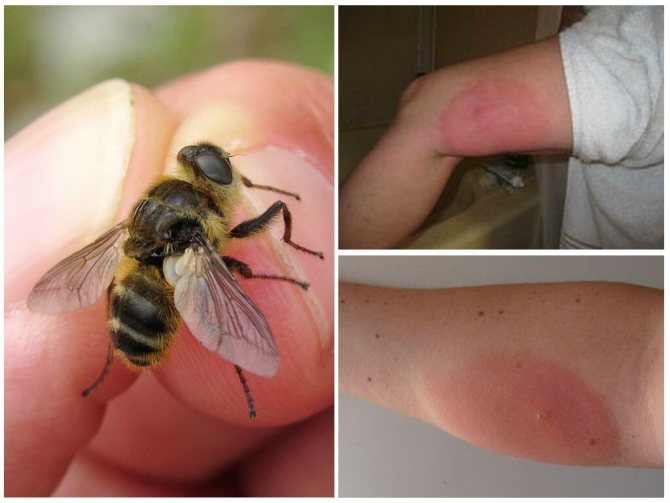

Gadfly bite
To prevent gadflies from biting on vacation or during work in the open air, certain conditions must be observed:
- do not wear too bright clothes, as insects react to color;
- it is better not to use sweetish perfumery, gadflies are attracted by this smell;
- stay away from water, grass and thickets - the favorite habitats of insects;
- after bathing, wipe the body and change into dry underwear;
- in the forest, wear light clothing that covers the body and limbs;
- use chemical or natural repellents;
- to have mosquito nets on the windows and doors of the house, in tents, so that you never know how the gadfly and gadfly of a defenseless person bite;
- protect the location of children's beds, cover strollers with special capes, through which insects cannot penetrate.
A gadfly bite on the human body always causes pain and swelling of the tissues adjacent to the wound. In the first minutes after piercing the skin with a bloodsucker, a gadfly bite looks like a papule. Later, the tumor spreads to adjacent tissues. Sometimes the papule does not turn into an extensive swelling, but becomes a bump at the bite point. So that there is no trace of an insect bite, you can cut out the resulting bump surgically.
Horseflies are not the only people who suffer.These parasites do not disdain any warm-blooded animals when they need to drink blood to breed their offspring. If there is no living flesh, then they drink blood even from the carrion. Our four-legged pets are also not immune from the attack of these monsters. Pet owners do not know how to treat a gadfly bite in an animal. After all, the dog can not say anything or show the place of damage to insects. It is especially dangerous if an animal has bitten an animal in the eye. In this case, the pet may remain blind or die from a painful shock. Therefore, if a gadfly has bitten a dog, you must contact a veterinary clinic.
Prevention and advice
There are general rules for the prevention of a gadfly bite. When going to the country house or nature, do not wear bright clothes, do not use saturated perfumes. Natural resources will help reduce the risk of an insect bite in nature. This insect does not like the smell of wormwood and tansy. The aroma of burnt chamomile stalks also scares off gadflies, and it is worth using mosquito nets indoors. While in nature, clothing should be as closed as possible, and in hot weather, use creams and sprays to protect against insects. Spend more time in the shade, the gadfly is a sunny insect and in shaded places its activity decreases.

